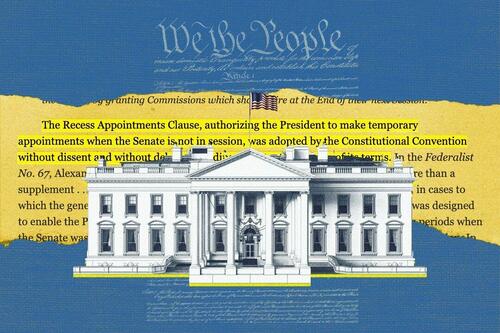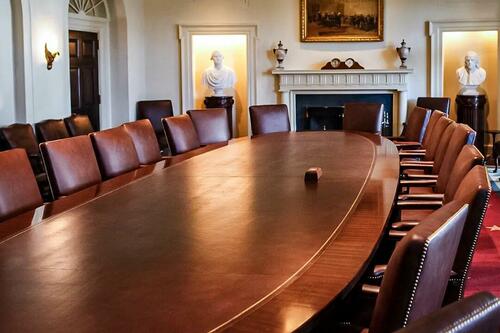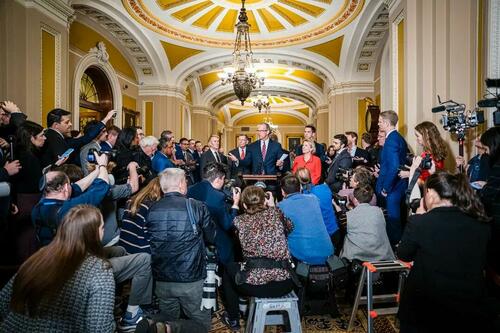Trump Promises To Use Recess Appointments If Needed, But What Are They?
Authored by Samantha Flom via The Epoch Times (emphasis ours),
President-elect Donald Trump has wasted no time in appointing his Cabinet members since his victory in the Nov. 5 presidential election.
In keeping with his promise to shake up Washington, some of his selections have raised eyebrows and questions about their chances to survive a potential confirmation battle in the Senate. But should his nominees stall, Trump has already identified a tool for sidestepping any delays: recess appointments.

Before the election of Sen. John Thune (R-S.D.) as the next majority leader, Trump said on social media that the next leader “must agree to Recess Appointments.”
He noted that confirmation votes can take “two years, or more,” because of the polarization in Congress.
“This is what they did four years ago, and we cannot let it happen again,” he said in the Nov. 10 post. “We need positions filled IMMEDIATELY!”
Upon Trump’s inauguration, some 4,000 administration positions will need filling, including more than 1,200 that require Senate confirmation, according to the Partnership for Public Service, a nonprofit that assists with presidential transitions.
Thune told Fox News on Nov. 14 that “all options are on the table” for ensuring Trump’s Cabinet appointments are confirmed.
The president’s Cabinet consists of the top advisers and agency and department heads who are appointed to help lead the executive branch.
Many of those roles require Senate confirmation, although others, such as the vice president or White House chief of staff, do not.
Here’s a rundown of the Cabinet confirmation process, how it has historically evolved, and the obstacles that Trump could face in getting his team confirmed.

What Is the Senate’s Role?
As outlined under Article II of the U.S. Constitution, the Senate’s “advice and consent” power gives it the authority to confirm or reject presidential appointments for Cabinet positions, ambassadorships, Supreme Court judges, and other officers of the United States.
That process starts when the Senate’s executive clerk refers a nominee to relevant committees for consideration. Those committees will delve into the appointee’s background and hold hearings to assess his or her qualifications. Members will then vote on how to report the nomination to the full chamber: favorably, unfavorably, no action, or without recommendation.
The full Senate will hold additional confirmation hearings and then vote on the nominee’s fitness for office, with a simple majority required for approval.
How Often Are Nominees Rejected?
Historically, only nine Cabinet nominations have been rejected by the Senate.
President John Tyler holds the record for most rejected nominations, at four. But the most recent occurrence was in 1989, when President George H.W. Bush’s appointment of John Tower, a senator from Texas, as his defense secretary was derailed by allegations of excessive drinking and sexual misconduct.
A handful of other nominations or near nominations were withdrawn either by the president or the appointees themselves as it became clear that they faced an uphill battle for confirmation.
That happened several times under Trump’s previous administration. In February 2017, his secretary of labor nominee, Andrew Puzder, withdrew his own name from consideration amid allegations of wage theft and sexual harassment leveled against restaurants franchised by his company.
Another notable example was Trump’s nomination of Dr. Ronny Jackson, the White House physician, for secretary of veterans affairs in 2018. Jackson denied allegations of workplace misconduct but eventually withdrew his name.

While rejections and withdrawals are rare, it is not uncommon for senators to use various legislative tactics to slow the confirmation process. In fact, in recent years, it has become an expected part of the process amid the increasing polarization of Congress.
One recent example was Sen. Tommy Tuberville’s (R-Ala.) use of legislative “holds” to block the chamber’s expeditious consideration of President Joe Biden’s Defense Department nominees.
For months, Tuberville blocked hundreds of military promotions in protest of the department’s decision to cover the travel expenses of service members seeking abortions. He ultimately dropped most of his holds when Majority Leader Chuck Schumer (D-N.Y.) indicated that he was preparing to bypass them and confirm hundreds of appointments at once.
What Are Recess Appointments?
Article II of the Constitution also empowers the president to fill vacancies while the chamber is in recess.
The drawback, however, is that recess appointees can serve only until the end of the Senate’s next session. That means that a recess appointee could serve for, at most, close to two years.
Monthslong recesses were not uncommon in Congress’s early years. Recess appointments allowed the president to ensure that important roles were filled if any vacancies arose during those extended absences.
In recent years, however, increasing gridlock in Washington has prompted presidents to use recess appointments—typically mid-term—to bypass delays in the Senate confirmation process.
Lawmakers, in turn, have limited opportunities for such appointments through creative scheduling and by holding “pro forma” sessions where no legislative work is conducted.
The Supreme Court unanimously upheld that practice in 2014. The court also ruled that the Senate must be in recess for at least 10 days before the president can make unilateral appointments.
As neither chamber can recess for more than three days without the other’s consent, the House also has some power over when recess appointments can be made.
Recent Uses
President Barack Obama was the last president to use the tool of recess appointments. He filled 32 positions in that fashion before he was sued over three appointments to the National Labor Relations Board.
The appointments in question were made during one of the Senate’s pro forma sessions and were invalidated by the Supreme Court’s 2014 ruling on recess appointments.
President Bill Clinton made 139 recess appointments and President George W. Bush made 171, according to the Congressional Research Service.
Read the rest here…
Tyler Durden
Thu, 11/21/2024 – 19:15

